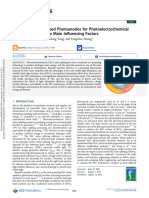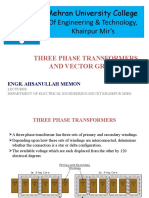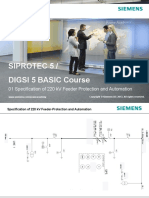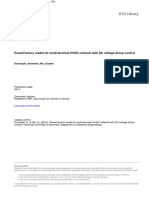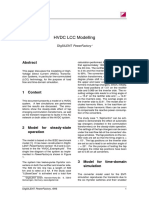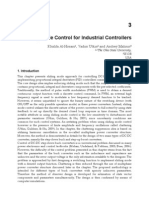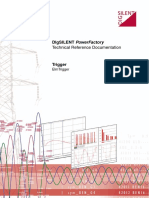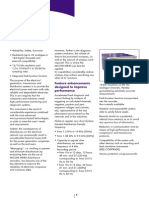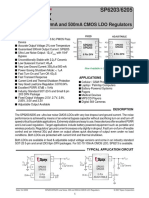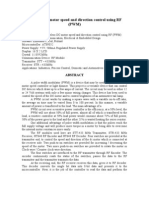HVDC LCC Modelling: Digsilent Powerfactory
HVDC LCC Modelling: Digsilent Powerfactory
Uploaded by
beimar heredia saiguaCopyright:
Available Formats
HVDC LCC Modelling: Digsilent Powerfactory
HVDC LCC Modelling: Digsilent Powerfactory
Uploaded by
beimar heredia saiguaOriginal Description:
Original Title
Copyright
Available Formats
Share this document
Did you find this document useful?
Is this content inappropriate?
Copyright:
Available Formats
HVDC LCC Modelling: Digsilent Powerfactory
HVDC LCC Modelling: Digsilent Powerfactory
Uploaded by
beimar heredia saiguaCopyright:
Available Formats
HVDC LCC Modelling
DIgSILENT PowerFactory ∗
Abstract calculation performed, the user may observe
that approximately 1000 MW flows through
the DC link. The rectifiers set the DC current
This paper discusses the modelling of High- to 2 kA and the inverters set the DC voltage
Voltage Direct Current (HVDC) Transmis- to 99%. The converter models include com-
sion Systems, in particular line-commutated mutation transformers, which provide the 30
(LCC) technology, for the purpose of load degree phase shift in AC voltage between
flow and time-domain simulation. the upper and lower converters. The trans-
formers include tap changers, which, initially,
have fixed positions of 1.01 on the rectifier
side and 0.989 on the inverter side. The re-
1 Content sulting voltage ratio leads to a firing angle of
α = 15.2◦ on the rectifier side and γ = 14.6◦
on the inverters side. The overlap angle on
This document presents a model of a HVDC the inverter side is 23.6◦ . The model also in-
system. A few simulations are performed cludes harmonic filters. In the load-flow cal-
and the results are discussed. The simu- culation these harmonic filters can be seen
lations show the steady-state effect of tap to compensate the reactive power consump-
changing commutation transformers, as well tion of the converters.
as the transient response to faults in the AC
network on both sides of the HVDC system. The study case ”1 TapControl” can be acti-
vated to demonstrate the effect of automatic
tap changers (installed in the commutation
transformers) on the steady-state operation.
2 Model for steady-state The settings of the tap changers can be seen
operation under the load flow tab of the converters’ dia-
logue windows. The tap positions on the rec-
tifier side are set so that the firing angle is α
The model is based on the IEEE benchmark = 15◦ . The tap positions on the inverter side
model [1]. It has been constructed in DIgSI- are set so as to lead to an extinction angle of
LENT PowerFactory version 15.0 and is con- γ = 20◦ . For the purpose of testing the tap
tained in the file ”HVDC Example.pfd”. The changers the initial tap positions have been
single line diagram of the system as imple- set to 0.95 on all converters.
mented in PowerFactory is shown in Figure
1.
The system has twelve-pulse thyristor con- 3 Model for time-domain
verters on both the rectifier and inverter side.
The 500 kV DC line has a length of 500
simulation
km and is rated at 2 kA. If the study case
”0 BaseCase” is activated and a load flow The converter model used for the EMT-
∗ DIgSILENT
GmbH, Heinrich-Hertz-Str. 9, 72810 simulation reproduces the transients due to
Gomaringen, Germany, www.digsilent.de the six thyristor switches and their snubber
DIgSILENT PowerFactory, r996 1
HVDC LCC Modelling
circuits. Either a built-in firing controller or AC system on the inverter side using a time-
a user-defined firing controller can be used. domain simulation (EMT).
The built-in firing controller represents EPC
(equidistant firing control). The firing angle After running the EMT simulation the sim-
is measured relative to an internal synchro- ulation plots appear in the graphics named
nising angle ”phiref”, which varies at the rate ”§. . . ”. The inverter phase currents in the
of the frequency signal that is connected to graphic ”AC Waveforms” display thyristor
the converter model. The frequency is mea- commutation failures (see Figure 2). The
sured by a phase-locked loop (PLL). The graphic ”§Rec Ctrl” shows that the VDCOL is
model requires the commutation reactance activated during the fault due to the reduction
to be entered correctly so that the internal in the DC voltage. The rectifier controller re-
angle ”phiref” can be initialised correctly. duces the DC current and alleviates the com-
mutation problems on the inverter side.
When either the study case ”2. . . ” or ”3. . . ” is
activated then the variations ”HVDC Control”
and ”Lower SCR” are activated. The for-
mer links dynamic controllers to the con-
verter models and the latter modifies the 5 Fault at the rectifier side
short-circuit levels of the external AC grid el-
ements.
The study case ”3 Fault Rectifier Side” is
The graphic ”HVDC Controls” provides
used to study the response of the HVDC sys-
an overview of the controls. It shows
tem to a three-phase short circuit in the AC
how the converter models are linked with
system on the rectifier side. The response
the dynamic controller models, phase-
is studied using a time-domain simulation
measurement devices and voltage & current
(EMT).
measurement devices.
After running the EMT simulation the plots
The graphic ”Rect Controller” shows the dy-
appear in the graphics named ”§. . . ”. The
namic model of the rectifier controller. Un-
firing angle on the rectifier side reduces to
der normal conditions, this controller regu-
the minimum value of 5 degrees, but the rec-
lates the DC current to the reference ”Id ref”,
tifier controller is unable to regulate the cur-
which is calculated from the load flow so-
rent to its set-point. The inverter controller
lution. In the event of a severe drop
switches to current control mode (see Figure
in the DC voltage the current reference
3). The inverter controller has a reference
is reduced through the VDCOL (voltage-
current equal to 90% (the initial 100% less
dependent current-order limiter).
a 10% margin). The inverter controller pre-
The graphic ”Inv Controller” shows the dy- vents the HVDC system from running down.
namic model of the inverter controller. Un- When the fault clears the rectifier controller
der normal conditions the controller regu- takes over current control again. After some
lates the extinction angle γ to gamma min, time the inverter controller switches back to
which is obtained from the load flow solu- extinction-angle control.
tion. In the event of a severe reduction in DC
voltage the controller can switch to current-
control mode. In this case the inverter regu-
lates the DC current (to the initial current less
the margin, Im). References
[1] M. Szechtman, T. Wess, and C.V. Thio.
4 Fault at the inverter side A benchmark model for HVDC system
studies. In International Conference on
AC and DC Power Transmission, pages
The study case ”2 Fault InverterSide” is 374–378. IET, 1991.
used to study the response of the HVDC
system to a three-phase short circuit in the
DIgSILENT PowerFactory, r996 2
HVDC LCC Modelling
Figure 1: Single line diagram for the HVDC system as modelled in PowerFactory
Figure 2: Commutation failure
Figure 3: Current control at the inverter
DIgSILENT PowerFactory, r996 3
You might also like
- Review On Bivo Based Photoanodes For Photoelectrochemical Water Oxidation: The Main Influencing FactorsDocument18 pagesReview On Bivo Based Photoanodes For Photoelectrochemical Water Oxidation: The Main Influencing Factorsgta gtaNo ratings yet
- The Technology of Instrument Transformers: Current and Voltage Measurement and Insulation SystemsFrom EverandThe Technology of Instrument Transformers: Current and Voltage Measurement and Insulation SystemsNo ratings yet
- 1 - Busbar - Protection - Webinar - PresentationDocument58 pages1 - Busbar - Protection - Webinar - PresentationSavvas KatemliadisNo ratings yet
- HVDC Offshore Wind Farm PDFDocument13 pagesHVDC Offshore Wind Farm PDFBryan Cuervo AriasNo ratings yet
- DS200 Installation GuideDocument39 pagesDS200 Installation GuideArokiaraj RajNo ratings yet
- VSC-FACTS-HVDC: Analysis, Modelling and Simulation in Power GridsFrom EverandVSC-FACTS-HVDC: Analysis, Modelling and Simulation in Power GridsNo ratings yet
- STATCOM - Working Principle, Design and Application - Electrical ConceptsDocument7 pagesSTATCOM - Working Principle, Design and Application - Electrical ConceptsJunaid BhattiNo ratings yet
- 12 - 308 - 1998 Variable Mvar Output Shunt Reactors PDFDocument12 pages12 - 308 - 1998 Variable Mvar Output Shunt Reactors PDFJorge Pinto RochaNo ratings yet
- Cable With Standing CurvesDocument63 pagesCable With Standing CurvesRatheesh R NairNo ratings yet
- Specification NGRDocument7 pagesSpecification NGRPrasenjit MaityNo ratings yet
- Data Bulletin Transformer Key Features: Dry-Type, Cast-Resin, and Liquid-Filled Transformers Class 7300Document4 pagesData Bulletin Transformer Key Features: Dry-Type, Cast-Resin, and Liquid-Filled Transformers Class 7300Dinesh SelvakumarNo ratings yet
- Neutral Grounding Professor Ahdab ElmorshedyDocument35 pagesNeutral Grounding Professor Ahdab ElmorshedyRama PrasadNo ratings yet
- PLL and Self-Synchronized Synchonverter: An Overview of Grid-Inverter Synchronization TechniquesDocument5 pagesPLL and Self-Synchronized Synchonverter: An Overview of Grid-Inverter Synchronization TechniquesNataly AvendañoNo ratings yet
- Inverter Modelling: 1 PurposeDocument23 pagesInverter Modelling: 1 PurposeLeonardo LeonNo ratings yet
- Transient Recovery Voltage AnalysisDocument18 pagesTransient Recovery Voltage AnalysisJosNo ratings yet
- IEEEPESApr14 - Grounding Configurations and Detection!Document66 pagesIEEEPESApr14 - Grounding Configurations and Detection!MrNo ratings yet
- DC Micro-Grid: A Concept Which Has The Potential To Solve Major ProblemsDocument11 pagesDC Micro-Grid: A Concept Which Has The Potential To Solve Major ProblemssorabhNo ratings yet
- Specifications Pakistan Review Report 23-08Document11 pagesSpecifications Pakistan Review Report 23-08Adil IftikharNo ratings yet
- Lightning Critical Flashover VoltageDocument8 pagesLightning Critical Flashover VoltageJosNo ratings yet
- Characteristics of Different Power Systems Neutral Grounding Techniques: Fact & FictionDocument12 pagesCharacteristics of Different Power Systems Neutral Grounding Techniques: Fact & FictionOcktafriandi HendraNo ratings yet
- CTreq forGErelays R6.9bookDocument97 pagesCTreq forGErelays R6.9bookVíctor Casado100% (1)
- Siemens Energy Sector Edition 7.1: 16 Power Engineering GuideDocument64 pagesSiemens Energy Sector Edition 7.1: 16 Power Engineering GuideCristian TeranNo ratings yet
- AusNet Services - AMS 10-60 - Earth Grids - Non Confidential - October 2015Document12 pagesAusNet Services - AMS 10-60 - Earth Grids - Non Confidential - October 2015andyhilbertNo ratings yet
- Siemens ERCOT RARF Workshop v1 6Document36 pagesSiemens ERCOT RARF Workshop v1 6mercuryandmarsNo ratings yet
- A Method For Wind Farm Reactive Power Controlling Using DIgSILENT and MATLABDocument16 pagesA Method For Wind Farm Reactive Power Controlling Using DIgSILENT and MATLABjorbol827No ratings yet
- 1376 Rekaguide To Usefor52 145kvDocument26 pages1376 Rekaguide To Usefor52 145kvparthaNo ratings yet
- ABB RelaysDocument58 pagesABB RelaysNandkumar ChinaiNo ratings yet
- Zig Zag Transformer For Grounding System PDFDocument5 pagesZig Zag Transformer For Grounding System PDFAnonymous N13JdnNo ratings yet
- Trans Vector GroupDocument23 pagesTrans Vector GroupmjohnNo ratings yet
- Core SaturationDocument3 pagesCore SaturationHRM, BAPEXNo ratings yet
- Kries-Energietechnik Catalogue 8 2017 EDocument88 pagesKries-Energietechnik Catalogue 8 2017 EANTONIO SOLISNo ratings yet
- 01 - D10 - Specification of 220 KV Feeder Protection and AutomationDocument4 pages01 - D10 - Specification of 220 KV Feeder Protection and AutomationcacobecoNo ratings yet
- STAR Exercise 4ADocument3 pagesSTAR Exercise 4Aashraf-84No ratings yet
- 3 HVDC Converter Control PDFDocument78 pages3 HVDC Converter Control PDFJanaki BonigalaNo ratings yet
- Some Aspects of System Modelling For The Estimation of Lightning Performance of High Voltage SubstationsDocument6 pagesSome Aspects of System Modelling For The Estimation of Lightning Performance of High Voltage SubstationsdankorankoNo ratings yet
- HVCapacitors ApplicationGuide en 32044A LTR 2018 04 R001 LRDocument26 pagesHVCapacitors ApplicationGuide en 32044A LTR 2018 04 R001 LRnknfiveNo ratings yet
- ABB Westermost Reference STATCOMDocument8 pagesABB Westermost Reference STATCOMProyectos IPC S.A.S - Manuel CadenaNo ratings yet
- Optimum Location of Static Var Compensator (SVC) in Over Head Transmission Lines C. Dinakaran G. BalasundaramDocument5 pagesOptimum Location of Static Var Compensator (SVC) in Over Head Transmission Lines C. Dinakaran G. BalasundaramM Yudi NugrohoNo ratings yet
- Ynynd11 Transformer ConnectionsDocument6 pagesYnynd11 Transformer ConnectionsGurunadha Rao RamachandraNo ratings yet
- VIZIMAX - CIGRE Toronto - Using A Controlled Switching Device For A Power Transformer PDFDocument8 pagesVIZIMAX - CIGRE Toronto - Using A Controlled Switching Device For A Power Transformer PDFgeorge_cpp2No ratings yet
- 2014 - PowerFactory Model For Multi-Terminal HVDC Network With DC Voltage Droop Control - A. Korompili, Q. WuDocument18 pages2014 - PowerFactory Model For Multi-Terminal HVDC Network With DC Voltage Droop Control - A. Korompili, Q. WuAaron CrucesNo ratings yet
- HVDC LDocument4 pagesHVDC LyesidNo ratings yet
- ITMF 2013 07 2 Predl ENUDocument8 pagesITMF 2013 07 2 Predl ENUbcqbaoNo ratings yet
- REDES DE SECUENCIA Zig Zag PDFDocument24 pagesREDES DE SECUENCIA Zig Zag PDFestebandavid2300No ratings yet
- Schneider Electric Cahier Technique 151Document24 pagesSchneider Electric Cahier Technique 151Anonymous BwLfvuNo ratings yet
- D CompensationDocument47 pagesD CompensationvenkataswarnaNo ratings yet
- Monitoring of Transient Overvoltages On The Power Transformers and Shunt ReactorsDocument14 pagesMonitoring of Transient Overvoltages On The Power Transformers and Shunt ReactorsParantap RahaNo ratings yet
- 2GHV092716 en B Controlled Switching of High-Voltage Circuit-Breakers GTIDocument16 pages2GHV092716 en B Controlled Switching of High-Voltage Circuit-Breakers GTIFredrikNo ratings yet
- Presentation About HVDC GeneratorDocument22 pagesPresentation About HVDC GeneratorFarhan Bukhari100% (1)
- Paper KimbarkDocument6 pagesPaper KimbarkRamiro VasquezNo ratings yet
- Equivalencing The Collector System of A Large Wind Power PlantDocument16 pagesEquivalencing The Collector System of A Large Wind Power PlantAaron VergaraNo ratings yet
- Electricity GenerationLicence HornsdalePowerReserveDocument12 pagesElectricity GenerationLicence HornsdalePowerReserveClaire DevNo ratings yet
- Hornsdale Power Reserve - Analysis of First Four Months of Operations - Final - Excluding AppendixDocument15 pagesHornsdale Power Reserve - Analysis of First Four Months of Operations - Final - Excluding AppendixkarunakaranNo ratings yet
- ABB Non Directional Earth Fault Setting GuideDocument8 pagesABB Non Directional Earth Fault Setting GuideKarthikeyan GuruNo ratings yet
- ABB Wind Turbine Converters: PCS6000, Full Power Converter, Up To 12 MWDocument12 pagesABB Wind Turbine Converters: PCS6000, Full Power Converter, Up To 12 MWgjghhdgNo ratings yet
- TR - 20190727 - E2 - UN38.3 Test Report ELPM762-00020 - V10 - CN&ENDocument14 pagesTR - 20190727 - E2 - UN38.3 Test Report ELPM762-00020 - V10 - CN&ENCristina CorfaNo ratings yet
- 5 Book Transfoemer Percent ImpedanceDocument6 pages5 Book Transfoemer Percent ImpedanceSLDC DDNo ratings yet
- Metal Enclosed Switched Shunt Reactor BanksDocument13 pagesMetal Enclosed Switched Shunt Reactor BanksaramirezbenitesNo ratings yet
- HVDC LCCDocument3 pagesHVDC LCCsf111No ratings yet
- Slidin Mode Research PaperDocument33 pagesSlidin Mode Research PaperAnimesh JainNo ratings yet
- Family Controller PFCDocument8 pagesFamily Controller PFCWesley de PaulaNo ratings yet
- DC Voltage Control and Stability Analysis of PWM-voltage-type Reversible RectifiersDocument12 pagesDC Voltage Control and Stability Analysis of PWM-voltage-type Reversible RectifiersAli ErNo ratings yet
- Weak AC GridDocument6 pagesWeak AC Gridshadjeri22No ratings yet
- MV Distribution Base Model: Application ExampleDocument2 pagesMV Distribution Base Model: Application Examplebeimar heredia saiguaNo ratings yet
- Digsilent Powerfactory: Technical Reference DocumentationDocument15 pagesDigsilent Powerfactory: Technical Reference Documentationbeimar heredia saiguaNo ratings yet
- Digsilent Powerfactory: Technical Reference DocumentationDocument11 pagesDigsilent Powerfactory: Technical Reference Documentationbeimar heredia saiguaNo ratings yet
- Niko Hydro Brochure - ENDocument16 pagesNiko Hydro Brochure - ENRanya KamelNo ratings yet
- 74LS164Document5 pages74LS164Byron MendozaNo ratings yet
- Eds Unit-2Document29 pagesEds Unit-2Bhavana Rushi DontuNo ratings yet
- Fernandez Ee3-1 Eeng70 Activity2Document6 pagesFernandez Ee3-1 Eeng70 Activity2Gabriel Glenn FernandezNo ratings yet
- Pramac Portable Generator E SERIES GENERATORDocument15 pagesPramac Portable Generator E SERIES GENERATORFilipe HortaNo ratings yet
- Service Manual Toshiba TV 27A35CDocument39 pagesService Manual Toshiba TV 27A35CfractalspaceNo ratings yet
- 2017 ANC Mic Display Connector DiagramDocument2 pages2017 ANC Mic Display Connector DiagrammariusNo ratings yet
- Brake Unit Instruction ManualDocument13 pagesBrake Unit Instruction Manuals_barriosNo ratings yet
- ManualDocument5 pagesManualjaved shaikh chaandNo ratings yet
- Quiz 8 - Attempt ReviewDocument3 pagesQuiz 8 - Attempt Reviewmajedcapiyoc.qcNo ratings yet
- SIP5 Hardware V06.00 Manual C002-8 enDocument202 pagesSIP5 Hardware V06.00 Manual C002-8 enAlexander AriasNo ratings yet
- Pricelist 2019: Lighting Houses Into Homes..Document20 pagesPricelist 2019: Lighting Houses Into Homes..Ferdinand Ramos EspirituNo ratings yet
- Standard - Automatic Defrost Refrigerator Models (: Service Data Sheet - 297299900Document1 pageStandard - Automatic Defrost Refrigerator Models (: Service Data Sheet - 297299900Carmen Adriana Garcia MendozaNo ratings yet
- 4.offshore Wind Plants With VSC-HVDC Connection and Their Impact On The Power System Stability (PDFDrive)Document96 pages4.offshore Wind Plants With VSC-HVDC Connection and Their Impact On The Power System Stability (PDFDrive)le hoai NamNo ratings yet
- ELEG 310L Prelab 4Document3 pagesELEG 310L Prelab 4ghaliaNo ratings yet
- BMU Series-Brushless Motors-AC InputDocument25 pagesBMU Series-Brushless Motors-AC InputMauro H. S. WencelewskiNo ratings yet
- Prinom B 2083 TDS PDFDocument2 pagesPrinom B 2083 TDS PDFjalilemadiNo ratings yet
- Physical Sciences p1 QP Nov 2022 EnglishDocument15 pagesPhysical Sciences p1 QP Nov 2022 EnglishmunashebatsiriNo ratings yet
- 7XV57 RS232 - RS485 Converter: Function OverviewDocument4 pages7XV57 RS232 - RS485 Converter: Function OverviewVictor Manuel BonettoNo ratings yet
- Voltage To Frequency Converter Folosind Ci 555 TimerDocument11 pagesVoltage To Frequency Converter Folosind Ci 555 TimerAl ZanoagaNo ratings yet
- ComPact NSX - LV431650Document4 pagesComPact NSX - LV431650ahmedalgaloNo ratings yet
- SP 6203 Voltage Regulator PDFDocument16 pagesSP 6203 Voltage Regulator PDFcesar gaiborNo ratings yet
- Drive System For Decentralized Installation PROFIBUS Interfaces and Field DistributorsDocument124 pagesDrive System For Decentralized Installation PROFIBUS Interfaces and Field DistributorsPitt O'GordoNo ratings yet
- 12 Chemistry Electrochemistry tp04Document5 pages12 Chemistry Electrochemistry tp04Arpit GuptaNo ratings yet
- Full Download Power Electronics: Advanced Conversion Technologies, Second Edition Fang Lin Luo PDFDocument53 pagesFull Download Power Electronics: Advanced Conversion Technologies, Second Edition Fang Lin Luo PDFtagouborlyNo ratings yet
- Wireless DC Motor Speed and Direction Control Using RFDocument3 pagesWireless DC Motor Speed and Direction Control Using RFNidhin MnNo ratings yet
- Table 2-1: Resistive CircuitsDocument62 pagesTable 2-1: Resistive Circuitsjorge enriqueNo ratings yet
- 500-989 Isolation For FFDocument0 pages500-989 Isolation For FFseba007_xNo ratings yet
